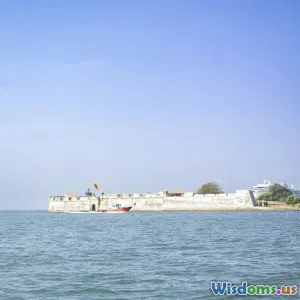
Can You Really Experience Local Culture on a Cruise Ship Vacation
8 min read Discover if cruise ship vacations truly offer an authentic local culture experience with our detailed analysis and real-world insights. (0 Reviews)
Can You Really Experience Local Culture on a Cruise Ship Vacation?
Introduction
Cruise ship vacations evoke images of luxury, ocean vistas, fine dining, and multiple destinations—all wrapped into a single trip. But beyond the shimmering pools and grand ballrooms lies a common traveler dilemma: can you truly experience local culture when your home base is a large, floating resort? With popular cruise lines docking for just a few hours in a destination, cultural immersion can often feel skimmed or superficial. Yet, some cruises claim to offer rich cultural encounters designed to connect passengers deeper with their port stops.
In this article, we'll explore whether you can really experience authentic local culture on a cruise ship vacation. We'll analyze the benefits and limitations, share real-world examples and travel expert opinions, and provide strategies to enhance your cultural engagement on these unmistakable travel machines. By the end, you’ll have a clear picture of what to expect and how to truly enrich your cruise experience.
Understanding the Cruise Ship Experience: A Double-Edged Sword
The Allure and Limitations
Cruises provide a convenient way to visit multiple destinations with minimal packing and unpacking, making them attractive for variety seekers. A recent report by Cruise Lines International Association (CLIA) noted over 30 million passengers worldwide in 2023, reflecting the growing interest.
Still, this convenience comes with constraints. Time is limited—ships often dock just long enough to allow short excursions, creating a ‘tourist checklist’ mentality rather than allowing for lingering cultural exploration. Luxury amenities onboard can sometimes insulate passengers from the very culture they have traveled to see.
Cruise itineraries tend to favor popular, accessible ports, which may have streets lined with souvenir shops rather than the authentic daily life of locals. For example, ports like Nassau in the Bahamas or Cozumel in Mexico often serve densely touristed areas rather than true local neighborhoods.
The Shore Excursion Dilemma
Many cruise passengers participate in shore excursions offered by the cruise line. These are designed to be hassle-free tours but can be scripted, commercial experiences that prioritize efficiency over depth. For instance, a cooking demonstration of ‘local’ dishes might actually feature Americanized meals catered to broader palettes.
That said, cruise companies have begun evolving. Lines such as Hurtigruten and Uniworld Market Focus on authentic cultural immersion, offering local guides and activities that support communities. Passengers onboard smaller expedition-style ships report deeper connections due to fewer passengers and curated local engagements.
Real-World Examples: When Cruise Culture Comes Alive
1. Norwegian Fjords—Cultural Festivals on Deck
In Norway’s fjord region, some cruise lines coordinate visits to small towns during local festivals, like Bergen’s International Festival. Passengers have access to traditional music, crafts, and food, offering a genuine glimpse of Norwegian culture. Here, the key driver is timing the cruise itinerary with local events.
2. Mediterranean Cruises and Culinary Immersion
Mediterranean cruises often anchor in ports like Barcelona, Rome, and Athens. Some savvy travelers enhance their cultural exposure by booking private local guides in advance or visiting markets like Barcelona’s La Boqueria to mingle with locals rather than staying within tourist zones. Combining self-led ventures with shore excursions can deepen cultural experience.
3. Alaska—Community Interaction Through Expeditions
Alaska cruises offer opportunities to engage with indigenous communities and learn traditional crafts, like at the Sitka National Historical Park. Eco-tourism-focused cruises encourage responsible travel by involving guests in local conservation projects or storytelling sessions with native elders.
These experiences illustrate that cruise cultural immersion is possible, especially when passengers actively seek depth beyond the offer onboard.
Strategies for Authentic Cultural Engagement from a Cruise Ship
Do Your Homework
Research ports in advance to understand the local culture and identify smaller, less touristy spots worth exploring. Tools like TripAdvisor forums, local tourism websites, and travel blogs provide nuanced advice.
Choose Smaller Ships or Expedition Cruises
Smaller vessels tend to dock in less commercialized ports and emphasize personalized, authentic experiences. Lines like Lindblad Expeditions or Silversea curate local engagement that large ships cannot replicate.
Go Beyond Cruise-Arranged Excursions
Opt for independent local guides or small group tours that prioritize cultural exchange instead of just sightseeing. Platforms such as GetYourGuide or ToursByLocals allow for vetted, authentic experiences.
Engage Directly with Locals
Visit markets, cafes, and community centers where locals gather. Learning a few local phrases, trying home-style food, or attending a community event can transform the shore visit.
Be mindful and respectful
Understanding local customs, supporting businesses ethically, and minimizing environmental impact can turn your cruise stop into a rewarding cultural encounter.
Expert Quotes and Opinions
Travel writer and cultural anthropologist Dr. Lila Ibrahim notes: “The cruise ship is not the enemy of cultural immersion; the issue is passive travel. Cruises are a platform—how passengers use the time ashore defines the quality of their engagement.”
Similarly, Captain Jonas Peters of an Alaskan expedition vessel remarks, “We strive to make our cruises an introduction to local heritage, not just a photo op. Education and interaction are at the journey’s heart.”
Conclusion: Can You Really Experience Local Culture on a Cruise?
Authentic cultural experience on a cruise ship vacation is not just a matter of booking a cruise but also how you approach the journey. Cruises offer unique access to multiple locations with relative ease, yet the genuine local connection requires intentional planning, curiosity, and stepping outside the sanitized cruise bubble.
By selecting itineraries aligned with local events, choosing smaller or expedition-style ships, hiring local guides, and actively engaging with communities, cruisers can bridge the gap between luxury travel and cultural authenticity. The cruise ship is a gateway—a floating starting point, not an endpoint—for discovery.
In short, yes, you can truly experience local culture on a cruise ship vacation, but only if you go beyond the surface and embrace the depth waiting in every port.
Ready to set sail with cultural immersion as your compass? Chart your course thoughtfully and discover the world beyond the railing.
Rate the Post
User Reviews
Other posts in Cruise Travel
Popular Posts















